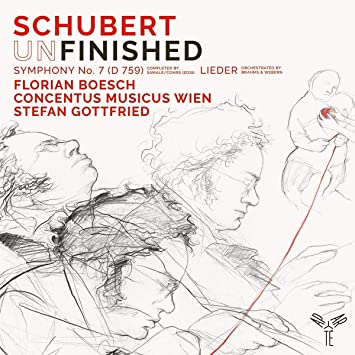 |
|
Aparté
- 1 CD - AP189 - (p) & (c) 2018
|
|
| Franz Schubert
(1797-1828) |
|
|
|
|
|
|
|
| Lieder in der
Orchesterfassung von Johannes
Brahms und Anton Webern |
|
|
|
| -
Tränenregen (Die Schöne
Müllerin, D 795, Nr. 10) · Anton Webern
- Ziemlich langsam |
|
4' 55" |
|
| - Der
Wegweiser (Winterreise,
D 911, Nr. 20) · Anton
Webern - Mäßig |
|
4' 06" |
|
| - Memnon
(D 541) · Johannes
Brahms - Sehr
langsam, schwärmerisch |
|
3' 34" |
|
| - Geheimes
(D 719) · Johannes
Brahms - Etwas
geschwind, zart |
|
1' 30" |
|
| - Ihr
Bild (Schwanengesang,
D 957, Nr. 9) · Anton
Webern - Langsam |
|
2' 30" |
|
| - Gruppe
aus dem Tartarus (D
583) · Johannes
Brahms - Etwas
geschwind |
|
2' 48" |
|
| - Du
bist die Ruh (D 776)
· Anton
Webern - Langsam |
|
4' 05" |
|
|
|
|
|
| Symphonie
Nr. 7 h-Moll "(Un)Vollendete", D
759 |
|
|
|
| -
Allegro moderato |
|
14' 06" |
|
| -
Andante con moto |
|
10' 31" |
|
| -
Scherzo: Allegro-Trio ·
Vervollständigung von Nicola Samale
und Benjamin-Gunnar Cohrs 2015 |
|
6' 57" |
|
| -
Finale: Allegro moderato ·
(Entr'acte Nr. 1 aus der
Schauspielmusik zu Rosamunde,
Fürstin von Zypern, D 797) |
|
11' 19" |
|
|
|
|
|
Florian Boesch, Bassbariton
CONCENTUS MUSICUS WIEN
Thomas Fheodoroff, Konzertmeister
Stefan Gottfried, Dirigent |
|
|
|
|
|
Enregistré |
|
Grande Salle,
Musikverein, Vienna (Austria) -
27-28 aprile 2018 |
|
|
live / studio |
|
studio |
|
|
Direction
artitstique |
|
Nicolas
Bartholomée |
|
|
Prise de son |
|
Nicolas Bartholomée
& Maximilien Ciup
|
|
|
Montage, mixage,
mastering |
|
Maximilien Ciup |
|
|
Prima Edizione CD |
|
Aparté - AP189
- 1 CD - 66' 24" - (p) & (c)
2018 - DDD
|
|
|
Note |
|
Recorded by Little
Tribeca
Cover: Drawing by Martha
Griebler (1948-2006) by
courtesy of the Estate of
Martha Griebler © Matthias
Griebler
|
|
|
|
|
Whenever
I attempted to sing of
love, it turned to pain.
And
again, when I tried to
sing of pain, it
turned to love.
This quotation, from
Franz Schubert’s prose sketch
"Mein Traum" - “My Dream” -
expresses the essence of what
makes his music so special:
the often almost unbearable
tension between happiness and
despondency, heaven and the
abyss, love and pain.
During his lifetime Schubert
was famous above all for his
lieder, in which text, voice
and piano blend so perfectly,
and time and again composers
were inspired to make
orchestral arrangements of his
songs.
Those of Johannes Brahms were
written for his friend and
colleague, the prominent
baritone Julius Stockhausen,
who played an important part
in promoting Schubert‘s music
by giving the pioneering
complete performances of his
song cycles, often with Brahms
at the piano.
Anton Webern's lieder
arrangements, on the other
hand, were made with no
specific purpose in mind,
other than immersion in the
composer's "so genuinely
Viennese" musical world. At
that time he was just
beginning to study with Arnold
Schoenberg. He orchestrated
the piano part, often only
sketchily, using a fine,
delicate palette, with subtle
touches of colour and unusual
timbre combinations (note, for
example, the ghostly effect
obtained by the use of muted
horns).
These arrangements afford a
completely new listening
experience, while giving us a
taste of the work of composers
who, for over a century, had a
substantial influence on
artistic life in Vienna.
The same existential intensity
is also to be found in
Schubert's instrumental music:
music without words, but with
a “musical discourse"
approaching the ineffable.
Schubert’s Symphony in B minor
(D 759) will always be
shrouded in mystery. ls it
really "unfinished"? What are
the reasons for its having
come down to us in this form?
Did Schubert's aforementioned
"Dream" play a part in the
process by providing a
"programme"? Apart from the
two complete movements with
which we are familiar, there
is also an autograph draft of
a complete third movement
(Scherzo, D 759/3), including
everything Schubert needed for
its later elaboration, and
even a complete orchestration
of its opening bars.
Furthermore, it is quite
likely that the first entr’acte
from Schubert’s incidental
music to Rosamunde (D
797/1), dating from the same
period, was intended to serve
as the symphony's Finale: this
monumental movement, lasting
almost four hundred bars, is
also in B minor, and it bears
many noticeable similarities
to the symphony. Indeed, many
motivic relations link both
the Scherzo and the entr'acte
with the symphony’s first two
movements. There is much to
indicate, therefore, that we
do in fact have a complete
symphony, one that explores
extreme tonal and emotional
contrasts. A symphony on a par
with Schubert's Great
C-major!
This is the first CD that the
Concentus Musicus Wien has
recorded since the death of
Nikolaus Harnoncourt, who, in
the course of countless
musical voyages of discovery,
had such a decisive influence
on of its musicians. Here the
ensemble sets sail for new
Romantic shores...
Stefan
Gottfried
Translation:
Mary Pardoe
|
|
|